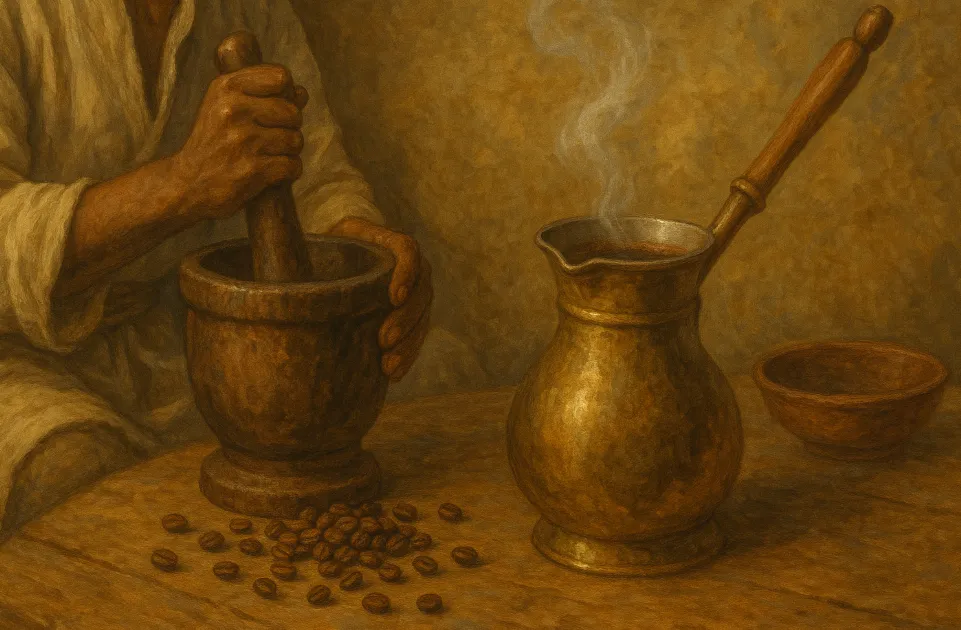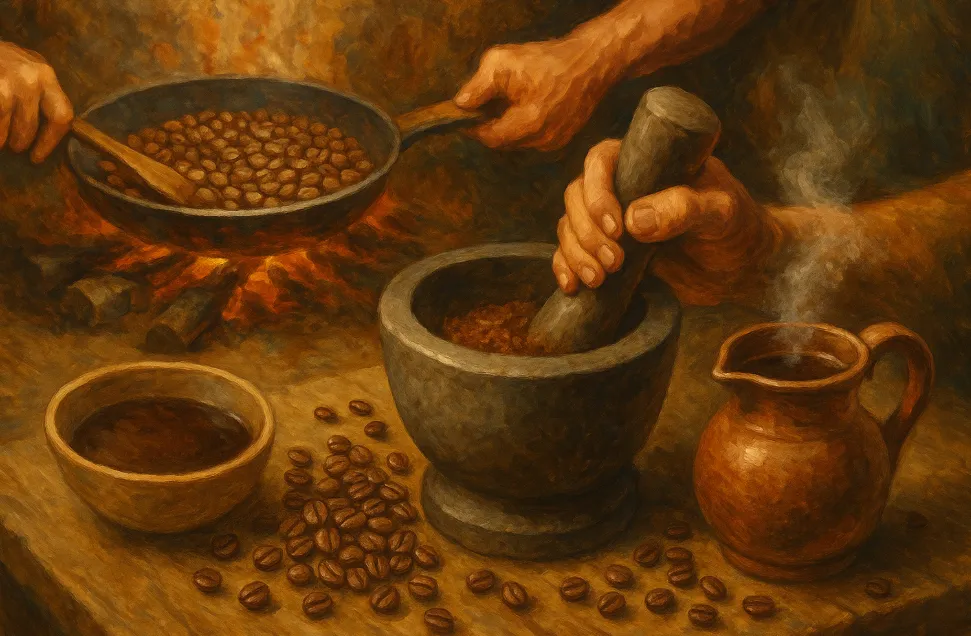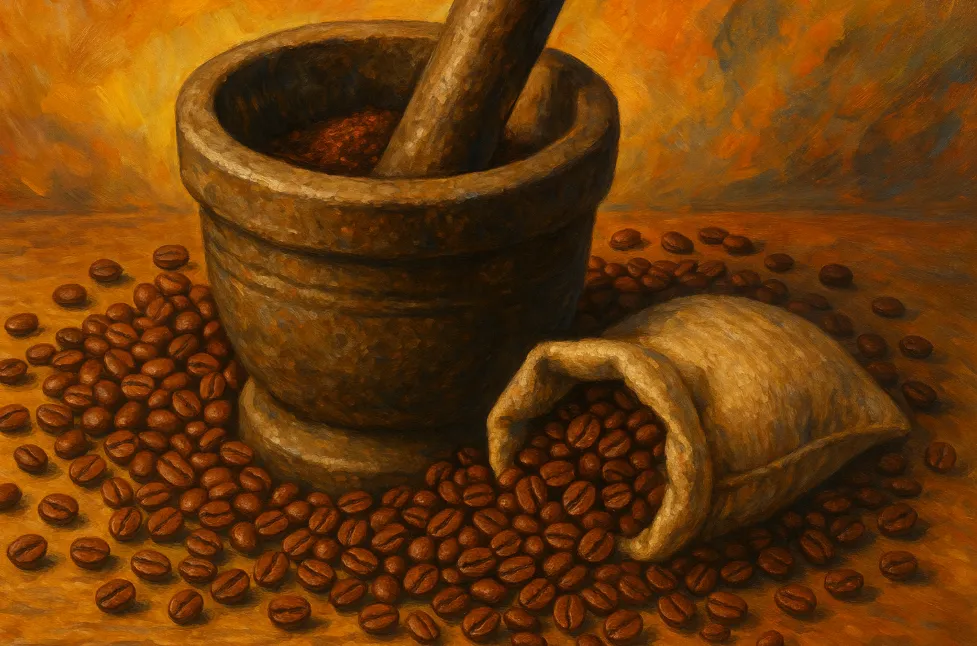Traditional Coffee Brewing Methods: Mortar & Pestle vs Turkish Ibrik - Complete Guide
Learn about ancient coffee brewing methods including mortar and pestle grinding and Turkish ibrik/cezve brewing. Discover how early coffee preparation techniques shaped modern brewing and why these traditional methods still matter today.
- Coffee Basics Nerds
- 5 min read

Traditional Coffee Brewing Methods: From Ancient Tools to Turkish Mastery
Before sophisticated espresso machines and paper filters, coffee lovers relied on ingenious traditional coffee brewing methods that maximized flavor using simple tools. These early coffee preparation methods - from mortar and pestle grinding to the elegant Turkish ibrik - represent the foundation of all modern brewing techniques and continue to produce exceptional coffee today.
After Kaldi’s legendary discovery in Ethiopia, coffee needed practical preparation methods. Let’s explore how our ancestors transformed raw coffee beans into the energizing beverage that would conquer the world.

Mortar and Pestle: The Original Coffee Grinder
The mortar and pestle coffee grinding method represents humanity’s first systematic approach to coffee preparation. This ancient coffee preparation technique required patience, skill, and an understanding of how grind size affects extraction.
The Complete Mortar and Pestle Process

Step 1: Roasting Over Open Fire
- Green coffee beans roasted over wood fires
- Roaster controlled color development by sight and smell
- Beans removed at desired roast level for immediate grinding
Step 2: Grinding While Warm
- Still-warm beans placed in stone or metal mortar
- Pestle used in circular motions to crack and crush beans
- Coarse, inconsistent grind resulted from manual process
Step 3: Brewing Like Tea
- Ground coffee added directly to boiling water
- Mixture simmered briefly to extract flavors
- Allowed to settle before pouring with sediment
Characteristics of Mortar and Pestle Coffee
- Rustic, gritty texture: Inconsistent grind created varied extraction
- Earthy flavor profile: Influenced heavily by roast level and bean origin
- Full-bodied brew: No filtration meant oils and fine particles remained
- Regional variations: Different stones and techniques created unique flavors
Why This Method Mattered: Mortar pestle coffee beans processing established the fundamental principle that grind size affects extraction - knowledge that remains crucial in modern coffee brewing methods explained today.
Turkish Ibrik/Cezve: Refined Coffee Artistry
The Turkish coffee ibrik (also called cezve) represents a quantum leap in coffee brewing sophistication. This traditional coffee brewing method produces an intensely flavored, ceremonial beverage that’s recognized by UNESCO as an Intangible Cultural Heritage.
Understanding the Ibrik vs Cezve

- Ibrik: Turkish name for the long-handled brewing pot
- Cezve: Regional variation of the same tool
- Materials: Traditional copper or brass construction for optimal heat conduction
- Design: Wide bottom, narrow top, long handle for heat protection
The Turkish Coffee Brewing Process
Preparation Phase:
- Ultra-fine grind: Coffee ground to powder-like consistency
- Cold water start: Coffee, water, and sugar (optional) combined cold
- Slow heating: Placed over low heat source (traditionally hot sand)
Brewing Phase:
- Gradual warming: Heat applied slowly to prevent scorching
- Foam development: Rich foam forms as temperature rises
- Multiple heat cycles: Removed from heat before boiling, repeated 2-3 times
- Final pour: Served immediately with grounds and foam intact
Turkish Coffee Characteristics
- Intense concentration: Fine grind and extended contact create strong flavor
- Thick, syrupy body: Oils and suspended particles create unique mouthfeel
- Ceremonial significance: Preparation and serving follow specific rituals
- Sediment inclusion: Grounds settling at bottom are part of the experience
Comparing Traditional Brewing Methods
| Method | Grind Size | Body | Clarity | Strength | Cultural Significance |
|---|---|---|---|---|---|
| Mortar & Pestle | Coarse, inconsistent | Heavy, gritty | Low | Medium-High | Foundation method |
| Turkish Ibrik | Ultra-fine powder | Thick, syrupy | Very low | Very High | UNESCO Heritage |
Why These Ancient Methods Still Matter
Modern Applications
Coffee enthusiasts today choose traditional methods for:
- Authentic flavor experiences: Taste coffee as it was originally intended
- Cultural connection: Experience coffee’s rich heritage firsthand
- Brewing mastery: Develop deeper understanding of extraction principles
- Unique characteristics: Achieve flavors impossible with modern equipment
Influence on Modern Brewing
These early coffee preparation techniques established principles used in contemporary methods:
- Grind size importance: Foundation for all modern brewing adjustments
- Heat control: Basis for temperature management in espresso and pour-over
- Extraction timing: Understanding contact time’s impact on flavor
- Cultural ritual: Coffee as social and ceremonial experience
The Evolution to Modern Methods
From these humble beginnings, coffee brewing evolved through:
- Cloth filtration and simple pots - First attempts at cleaner extraction
- European coffee house innovations - Social brewing requirements
- Industrial revolution advances - Mechanical grinders and brewing devices
- Modern precision brewing - Electronic controls and scientific understanding
Trying Traditional Methods Today
Getting Started with Mortar and Pestle
- Choose quality tools: Heavy mortar with rough interior surface
- Start with medium roast: Easier to grind and more forgiving flavors
- Practice grind consistency: Aim for uniform particle size through technique
- Experiment with ratios: Traditional methods allow significant customization
Turkish Coffee at Home
- Invest in proper ibrik: Copper construction makes significant difference
- Master the grind: Ultra-fine powder essential for proper extraction
- Practice heat control: Low, steady heat prevents scorching
- Embrace the ritual: Slow preparation is part of the experience
The Timeless Appeal of Traditional Brewing
These traditional coffee brewing methods remind us that great coffee doesn’t require expensive equipment - just understanding, patience, and respect for the process. Whether you’re grinding beans with a mortar and pestle or mastering the Turkish coffee ibrik, you’re connecting with centuries of coffee tradition and developing skills that enhance all your brewing.
The journey from these ancient techniques to modern precision brewing shows how fundamental principles remain constant while technology evolves. Every cup brewed with traditional methods carries the wisdom of generations who perfected these techniques through daily practice and cultural preservation.
Continue exploring coffee’s fascinating history with our guides to how coffee culture spread across continents and the role of coffee houses in shaping society.
You might also like:
- Tags:
- Coffee Brewing Methods
- Turkish Coffee Ibrik
- Mortar and Pestle Coffee
- Traditional Coffee Brewing
- Coffee Brewing Methods Explained
- Ancient Coffee Preparation
- Ibrik vs Cezve
- Coffee History Timeline
- Green Coffee
- Grind Size
- Flavor Profile
- Coffee Water
- Coffee Beans
- Espresso Machines
- Coffee Culture
- Coffee Brewing
- Ground Coffee
- Coffee Grounds
- Particle Size
- Paper Filters
- Brewing Methods
- Fine Grind
- Roast Level
- Modern Coffee
- Body Clarity
- Brewing Method
- Inconsistent Grind
- Coffee Houses
- Fine Particles
- Desired Roast
- Grind Consistency
- Turkish Coffee
- Cold Water
- Cultural Heritage
- Applications Coffee
- Cultural Significance
- Coffee House
- Boiling Water
- Impact Flavor
- Precision Brewing
- Beans Placed
- Coffee Preparation
- Traditional Methods
- Brewing Process
- Heat Control
- Syrupy Body
- Traditional Brewing
- Coffee Fascinating